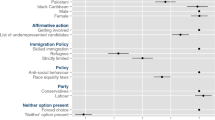Abstract
We extend the standard Downsian framework to suppose that voters consider the identity of each candidate's supporters when deciding whom to support, rather than considering only the announced policy positions of the candidates. In particular we posit the existence of a class of voters whose support for a candidate reduces support by some other voters for that candidate. Our most important result concerns the conditions under which the addition to the electorate of new voters on one side of the policy spectrum shifts the equilibrium toward the opposite direction. The model can explain why enfranchisement of blacks did not immediately help the election of liberal candidates.
Similar content being viewed by others
References
Aldrich, J. H. (1983). A Downsian spatial model with party activism. American Political Science Review 77: 974–990.
Alesina, A. and Rosenthal, H. (1993). Partisan politics: Divided government. New York: Cambridge University Press.
Alt, J. (1994). Race and voter registration in the South. In C. Davidson and B. Grofman, Quiet revolution in the South: The impact of the Voting Rights Act. Princeton: Princeton University Press.
Aranson, P. and Ordeshook, P. C. (1972). Spatial strategy for sequential elections. In R.G. Niemi and H.F. Weisberg (Eds.), Probability models of collective decision making. Columbus OH: Merrill.
Baron, D. D. (1994). Electoral competition with informed and uninformed voters. American Political Science Review 88: 33–47.
Black, E. and Black, M. (1992). The vital South: How presidents are elected. Cambridge, MA: Harvard University Press.
Brennan, G. and Lomasky, L. (1994). Democracy and decision: The pure theory of electoral preference. New York: Cambridge University Press.
Carmines, E. G. and Stimson, J. A. (1989). Issue evolution: Race and the transformation of American politics. Princeton: Princeton University Press.
Downs, A. (1957). An economic theory of democracy. New York: Harper.
Fenno, R. F. (1978). Home style: House members in the their districts. Boston: Little Brown.
Glazer, A. (1993). Political equilibrium under group identification. In B. Grofman (Ed.), Information, participation and choice. Ann Arbor: University of Michigan Press.
Grofman, B. (1982). A dynamic model of protocoalition formation in ideological N-space. Behavioral Science 27: 77–90.
Grofman, B. (1993). Toward an institution-rich theory of political competition with a supply side component. In B. Grofman (Ed.), Information, participation and choice. Ann Arbor: University of Michigan Press.
Grofman, B. and Handley, L. (1995). Racial context, the 1968 Wallace vote, and southern presidential dealignment: Evidence from North Carolina and elsewhere. In M. Eagles (Ed.), Spatial and contextual models in political research. London: Taylor and Francis.
Grofman, B., Griffin, R. and Glazer, A. (1990). Identical geography, different constituencies, see what a difference party makes. In R.J. Johnston, F. Shelley, and P. Taylor (Eds.), Developments in electoral geography, 207–217. London: Croom Helm.
Grofman, B., Griffin, R. and Glazer, A. 91992). The effects of black population on electing Democrats and liberals to the House of Representatives. Legislative Studies Quarterly 17: 365–379.
Huckfeldt, R. and Kohfeld, C. (1989). Race and the decline of class in American politics. Champaign-Urbana: University of Illinois Press.
Keech, W. R. (1968). The impact of Negro voting: The vote in the quest for equality. Chicago: Rand McNally.
Key, V. O. Jr. (1949). Southern politics. New York: Knopf.
Lodge, M., Moskowitz, D., Pfau, M. and Ramachandran, S. (1985). Discriminating tweedledum from tweedledee: Perceived party preferences as a function of social class and racial differences. Prepared for delivery at the Annual Meeting of the American Political Science Association, New Orleans, August.
Lodge, M., Moskowitz, D., Pfau, M. and Wahlke, J. (1986). Race and class components of party differences: An experiment in political information processing. Unpublished manuscript. Laboratory for Behavioral Research, State University of New York at Stony Brook.
McConahay, J. B. (1982). Self-interest versus racial attitudes as correlates of anti-busing attitudes in Louisville: Is it the buses or the blacks? Journal of Politics 44: 692–720.
Poole, K. and Rosenthal, H. (1984). A spatial model for legislative roll-call analysis. American Journal of Political Science 29: 357–384.
Sears, D. O., Hensler, C. P. and Speer, L. K. (1979). White's opposition to busing: Self-interest or symbolic politics? American Political Science Review 73: 369–384.
Sears, D. O. and Kinder, D. (1971). Racial tensions and voting in Los Angeles. In W.Z. Hirsch (Ed.), Los Angeles: Viability and prospects for metropolitan leadership. New York: Praeger.
Wittman, D. (1977). Candidates with policy preferences: A dynamic model. Journal of Economic Theory 14: 180–189.
Wittman, D. (1983). Candidate motivation: A synthesis of alternative theories. American Political Science Review 72: 78–90.
Wright, G. C. (1977). Contextual models of electoral behavior: The southern Wallace vote. American Political Science Review 71: 497–508.
Author information
Authors and Affiliations
Rights and permissions
About this article
Cite this article
Glazer, A., Grofman, B. & Owen, G. A neo-Downsian model of group-oriented voting and racial backlash. Public Choice 97, 23–34 (1998). https://doi.org/10.1023/A:1004906708125
Issue Date:
DOI: https://doi.org/10.1023/A:1004906708125




